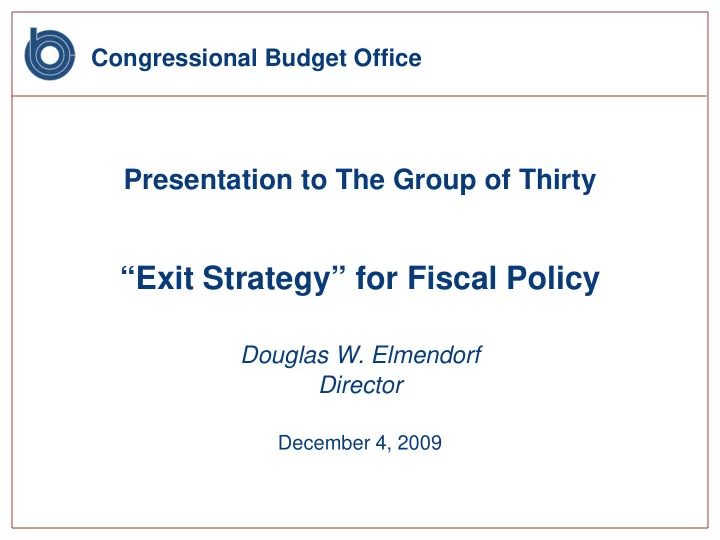

Congressional Budget Office Presentation to The Group of Thirty “Exit Strategy” for Fiscal Policy Douglas W. Elmendorf Director December 4, 2009
Congressional Budget Office Consists of 250 people working for the U.S. Congress. Provides objective, nonpartisan analysis of budget and economic issues. Makes no policy recommendations. 2
Fiscal Policy Challenges Given the likely evolution of the economy, the current path of fiscal policy poses two central challenges to macroeconomic stability: Fiscal stimulus will be withdrawn very rapidly between 2010 and 2012. Fiscal stimulus will not be reduced any further after 2012. 3
Slow Return to Normalcy (from August Forecast) Unemployment Rate in Percent Actual Projected 4 Calendar Year
Withdrawal of Fiscal Stimulus Federal Deficit as a Percentage of GDP 12 10 8 6 4 Baseline Excluding the 2 American Recovery and Reinvestment Act of 2009 0 2009 2010 2011 2012 2013 2014 2015 2016 2017 2018 2019 Fiscal Year 5
Estimated Effect of the American Recovery and Reinvestment Act of 2009 on Employment Millions of Jobs 4 High Estimate 3 2 Low Estimate 1 0 2009 2010 2011 2012 2013 2014 2015 2016 2017 2018 2019 Calendar Year 6
Fiscal Policy Options to Boost Output and Employment Encourage Job Creation Directly – Job tax credits – Payroll tax holiday – Government jobs Support Businesses – Investment incentives – Improved access to credit Stabilize Mortgage and Housing Markets – Expansion of loan guarantees or mortgage modification Boost Demand – Aid to states – Infrastructure projects – Extension of 2001 and 2003 tax cuts – Indexing of Alternative Minimum Tax (AMT) 7
Effect of Extending the 2001 and 2003 Tax Cuts and Indexing the AMT Federal Deficit as a Percentage of GDP 12 10 8 Extend Tax Cuts and 6 Index AMT 4 Baseline 2 0 2009 2010 2011 2012 2013 2014 2015 2016 2017 2018 2019 Fiscal Year 8
Rising Debt Burden Federal Debt Held by the Public as a Percentage of GDP 120 120 Projected Actual 100 100 Extend Tax Cuts and Index AMT 80 80 60 60 Baseline 40 40 20 20 0 0 1940 1950 1960 1970 1979 1989 1999 2009 2019 Fiscal Year 9
Outlays for Key Federal Programs Will Soon Exceed Total Federal Revenues Percentage of GDP 20 Actual Projected Revenues, with Tax Cuts Extended and 18 AMT Indexed Outlays for Medicare, Medicaid, Social Security, Defense, and Net Interest 16 14 0 2008 2009 2010 2011 2012 2013 2014 2015 2016 2017 2018 2019 Fiscal Year 10
Population Aging Population Age 65 or Older as a Percentage of the Population Ages 20 to 64 50 Actual Projected 40 30 20 10 0 1962 1972 1982 1992 2002 2012 2022 2032 2042 2052 2062 2072 11 Fiscal Year
Health Care Reform and Budget Deficits CBO estimates that the health care reform proposals that have passed the House and are being considered in the Senate would reduce budget deficits slightly. Commonly expressed concerns: CBO is underestimating the ultimate costs of the new subsidies to buy health insurance. Congress will not allow the Medicare spending cuts in the proposals to take effect. Spending cuts and new revenues would pay for a new program rather than cover the costs of existing ones. The proposals are missing opportunities to reduce health care spending more significantly. 12
Long-Run Fiscal Policy The United States faces a fundamental disconnect between the services that people expect the government to provide, particularly in the form of benefits for older Americans, and the tax revenues that people are willing to send to the government to finance those services. Widespread concern about the unsustainable long- run path of fiscal policy matters in the short run as well, because it will (at some point) push up interest rates and will (quickly) reduce political support for fiscal actions to boost output and employment. 13
Recommend
More recommend